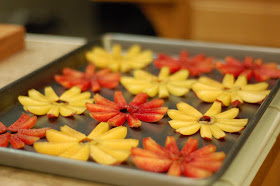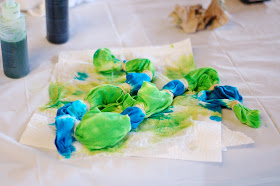As part of my oldest daughter's room revamp, my husband and I created these fabric-covered canvases for her wall. It ended up being sort of Andy Warhol-esque, and I am so happy with how it all turned out and looks on her freshly painted walls!
I started by gathering some supplies...
*fabric that coordinated with her room colors
*4 - 11x14 art canvases from Michaels
*a few foam paint brushes and some paper cups
*I also used a rotary cutter and cutting mat, however you could also use fabric scissors
***(not pictured) stencils of desired artwork, pencil, thin paint brush, and latex paint
Lay out the fabric and canvas, cut a rectangle of fabric larger than the canvas by a few inches. This doesn't need to be precise (I used the rotary cutter), the edges will not be seen on the back.
I grabbed my bottle of Collage Pauge decoupage. In this case I used the matte finish. If you have never used a decoupage product, it is a glue, sealer, and finishing top-coat all in one. Very cool. Very addicting. I find myself looking for items to decoupage. Just saying... you might be seeing a few more projects featured on the blog using this product in the near future.
Paint a generous coat of the decoupage directly onto the canvas.
Place the fabric on top of the decoupaged canvas. Smooth out any wrinkles or bubbles. This product has a tendancy to bubble up, so be aware and smooth out accordingly.
Paint another generous coat (or two) of the decoupage directly on top of the fabric.
Cut in from the corners of the extra fabric to the outer edge of the canvas, then cut straight up the sides. Basically, you need a square cut out from each corner in order to decoupage the fabric to the sides of the canvas.
Gently flip the fabric back and paint the edge of the canvas with the decopauge. Flip the fabric back down and smooth by pulling it tightly around the edge. Seal with another coat of decoupage over the fabric. Repeat around all four sides of the canvas, and then again to the back of the canvas.
*I usually get my fingers pretty sticky at this point. I found that by pulling and smoothing the fabric as tighly as I could around the edges and back I prevented as many wrinkles and bubbles as possible.
Wait until all fabric-covered canvases are dry. I waited at least 24 hours before moving onto the next step.
Find a stencil or object(s) you would like to use as your artwork and trace it onto the dry canvases.
A few shots of the finished products...
And finally, proudly displayed on the wall. Lovingly refered to as 'the Birds' :)










































